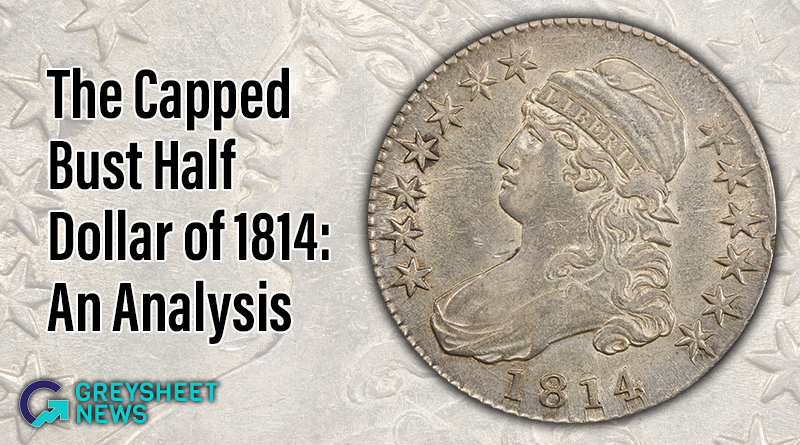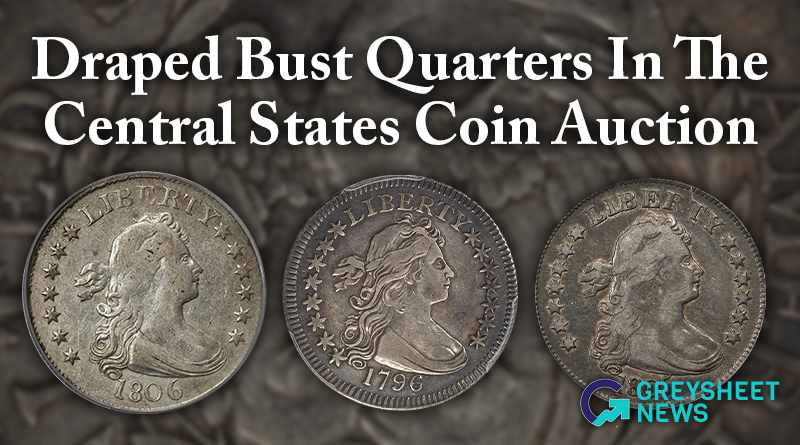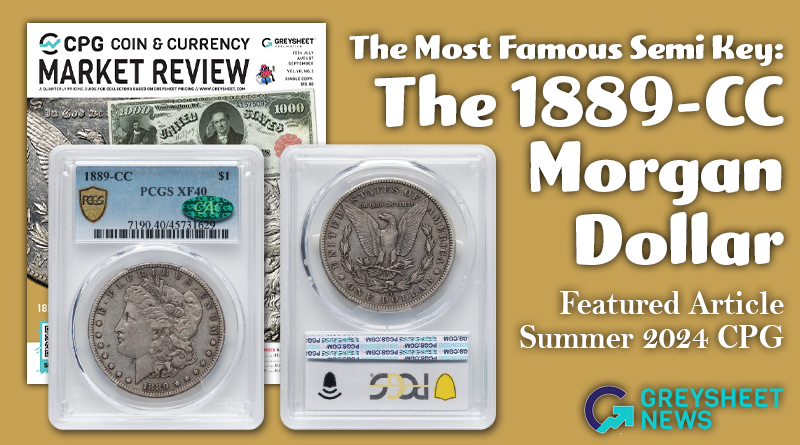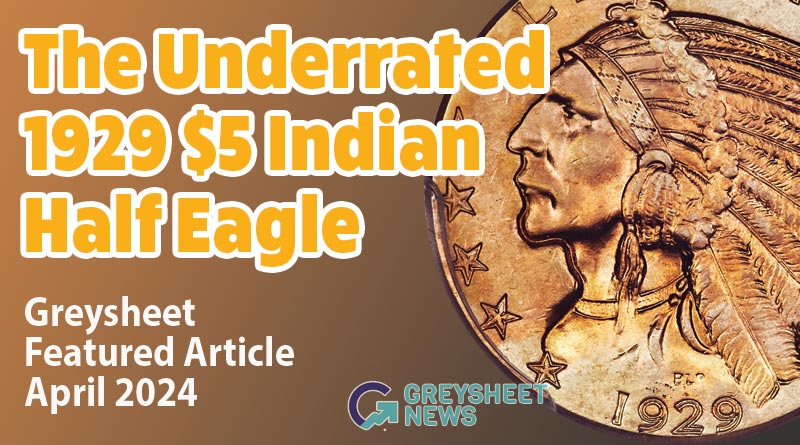An Overlooked Key Date U.S. Coin: The 1929 Half Eagle
Underrated, and in the shadows of its more-heralded 1909-O cousin, the 1929 is much scarcer.
It is not widely recognized that the 1929 half eagle is much scarcer than the key 1909-O overall, especially in circulated grades. Indian Head half eagles ($5 gold coins) were minted from 1908 to 1916 and again in 1929.
These and their little brothers, Indian Head quarter eagles ($2.50 gold coins), are among the most popular gold series with collectors, because common dates tend to be very inexpensive and because it is relatively practical to complete sets by date (and mint location). There are no very rare dates in either series.
The 1909-O is the most famous of all Indian Head half eagles. Indeed, since I was a kid, I have heard collectors talk with energy about 1909-O half eagles, and have been reading enthusiastic descriptions of 1909-O half eagles in catalogues. Those who talk about 1909-O half eagles, however, seldom mention 1929 half eagles.
Whenever a top-notch set of Indian Head half eagles is sold at auction, interested collectors and dealers immediately hone in on the 1909-O. I have analyzed the Eliasberg-O’Neal 1909-O half eagle and others that have been highly certified. I still remember Jay Parrino beaming after buying the Eliasberg 1909-O in the Akers auction of the Thaine Price Collection in 1998. Moreover, years ago at various times, I had fervent discussions regarding 1909-O half eagles with David Akers, John Albanese, Charles Browne, Dr. Steven Duckor, Matt Kleinsteuber, and Kris Oyster. I thank all of them for contributing to my understanding of 1909-O half eagles and the demand for them. No one, though, demonstrated much interest in talking about 1929 half eagles, although they are scarcer.
Common Indian Head half eagles, like the 1909-D and the 1911, are easy to acquire. The PCGS population report lists 43,289 1909-D half eagles, and 17,150 1911 half eagles. Similarly, the NGC census reports 35,797 1909-D half eagles and 11,378 1911 half eagles. As for the 1909-O, the PCGS population is 747 and the NGC census is 1,076. Even considering that population reports are notably imperfect, the 1929 is obviously scarcer than the 1909-O, with a PCGS population of 392 and an NGC census of 234.
Unlike the 1909-O, where the survivors are spread throughout the Very Fine to MS64 grade range, the population of 1929s is very heavily bunched in the MS63 to MS64 range, with a small number certified as grading below MS62. In my estimation, the totals in the MS63 to MS64 range include numerous resubmissions of the same individual coins. For 1929 half eagles, it is very difficult to distinguish a MS63+ grade coin from a MS64 and even harder to distinguish a MS64+ from a MS64 grade 1929. Many of these came from original rolls, and almost all have noticeable contact marks.
As a certified MS65 grade 1929 is worth around twice as much as a MS64 grade 1929 that is certified by the same service, and a grading fee is just a small percentage of the difference in value, many PCGS or NGC graded MS64 grade 1929 half eagles have been ‘cracked out’ and resubmitted in hopes of a higher grade. While some grading-wholesalers return the printed labels (inserts) from crackouts, many do not or do not return all of them. In some cases, they do not wish for others to know the extent to which they are cracking coins out of PCGS and NGC holders.
An immediate point is that the PCGS population of 118 and the NGC census of 71 in MS64 include substantial numbers of resubmissions of the same individual coins, especially resubmissions from the days when the maximum show grading fee was in the $100 to $125 range. If a dealer has potentially $40,000 or far more to gain from an upgrade, a $125 fee did not seem to be a large barrier. Grading fees are higher now than they were in the 1990s and early 2000s, yet crackouts and resubmissions continue.
Before buying a 1929 half eagle, it is a good idea to consult an expert, especially if the buyer is planning to spend an amount that he or she regards as a lot of money. In an article titled “A Low Cost Set of Half Eagles" in the July 2021 issue of The CPG® Coin & Currency Review, I estimated that there are between 480 and 635 1929 half eagles in existence.
Including 1929 half eagles in Details holders, there are probably fewer than 700 certified by PCGS and NGC in total. The sum probably amounts to 460 to 530 different certified coins, and there are, undoubtedly, some 1929 half eagles that have never been sent to PCGS or NGC, including a few residing in bank vaults in Europe.
For every other date in the series of the Indian Head half eagles, except the 1909-O, thousands exist in the present. Indisputably, more than 1,200 1909-O half eagles survive. An interesting point is that NGC reports 588 1909-O half eagles in Details holders, yet only 35 1929 half eagles, despite the fact that 1929 half eagles in Details holders are usually worth considerably more than equivalent or very similar 1909-O half eagles in Details holders. Coins in CACG, NGC or PCGS Details holders failed to receive numerical grades because of serious problems.
There is not a need to think about Details holders to acquire a 1929. Those with numerical grades are around.
On May 5, 2022, Heritage auctioned a PCGS graded MS62 1929 for $33,600. During the last decade, Heritage auctioned PCGS graded MS62 1929 half eagles for more: $38,775 on November 1, 2016, $37,600; on August 12, 2015; and $41,125 on October 9, 2014. Not one of these four has a CAC sticker. I mention these, as they are among many bits of evidence that taken together indicate that 1929 half eagles were not part of the boom in better date gold coins that began in January 2021 and roared in 2022.
On January 12, 2023, Heritage auctioned a CAC approved, PCGS graded MS64 1929 for $46,800. Results in auctions for 1929 half eagles eight to twelve years earlier were higher. On January 7, 2015, Heritage auctioned a CAC approved, PCGS graded MS64 1929 for $54,050. On August 20, 2013, Stack’s Bowers auctioned a CAC approved, PCGS graded MS64 1929 for $70,500.
On November 20, 2012, Stack’s Bowers auctioned a PCGS graded MS64+ 1929, with a CAC sticker, for $63,250. On August 3, 2012, a CAC approved, PCGS graded MS64 1929 realized $64,625. On June 29, 2012, Stack’s Bowers auctioned a PCGS graded MS64 1929, without a CAC sticker, for $51,750.
In recent times, Heritage has auctioned three PCGS graded MS65 1929 half eagles: for $81,000 on January 11, 2024; for $78,000 on August 15, 2023; and for $90,000 on July 20, 2023. These are three different coins and not one of them has a CAC sticker.
Back in June 2016, the Goldbergs auctioned a PCGS graded MS65 1929, without a CAC sticker, for $102,813. Also, the same coin that brought $90,000 in July 2023 was auctioned by Heritage for $86,250 on January 6, 2011.
While no small selection of auction results demonstrates a point regarding market levels, a substantial number of pertinent prices realized suggest that market levels for 1929 half eagles were not significantly higher, if higher at all, during the winter of 2024 than they were during the bull market for U.S. coins from 2011 or so to the middle of 2015. In contrast, many better date nineteenth century U.S. gold coins have more than doubled in value since the 2012 to 2015 period.
Copyright ©2024 Greg Reynolds
Insightful10@gmail.com
Images courtesy of Heritage Auctions, HA.com

Download the Greysheet app for access to pricing, news, events and your subscriptions.
Subscribe Now.

Subscribe to The Greysheet for the industry's most respected pricing and to read more articles just like this.
Source: Greg Reynolds
Related Stories (powered by Greysheet News)
View all news
In this article Greg Reynolds analyzes the 1814 Capped Bust Half Dollar.

The Lusk set of Draped Bust quarters brought strong results.

The 1889-CC is the second scarcest business strike in the series.









Please sign in or register to leave a comment.
Your identity will be restricted to first name/last initial, or a user ID you create.
Comment
Comments